| 上传:English | 审核发布:admin | 更新时间:2015-3-24 14:31:57 | 点击次数:719次 |

Teaching and Learning Goals:
一、知识目标:1.Learn to use The Imperative Sentence.
2.Learn to use The Imperative Sentence to talk about rules,
Such as school rules, family rules, library rules and so on.
二、情感态度:引导学生学会遵守规则,树立正确的人生观、世界观。
三、学习策略:采用“三元”教学法。即从含义、结构和标志着手,感知-练习-巩固-习得。用小组合作探究的方式,引导学生观察、比较、归纳,进而习得新知识。


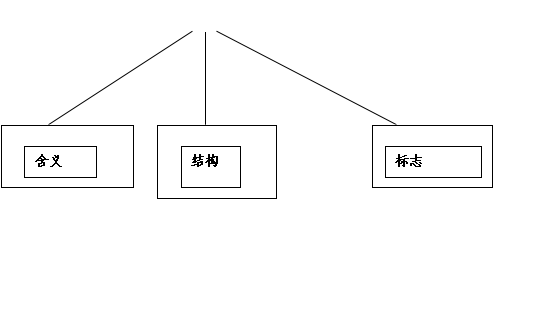
Learning procedures:
Step1: Review
Lead Ss look back on the rules at our school. Get Ss look at the PPT pictures and write them down on a piece of paper . And then check these sentences each other.

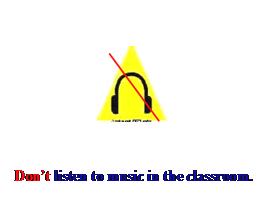
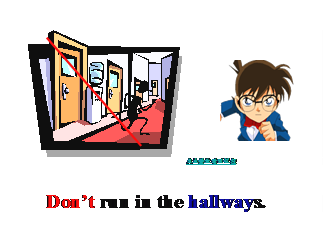
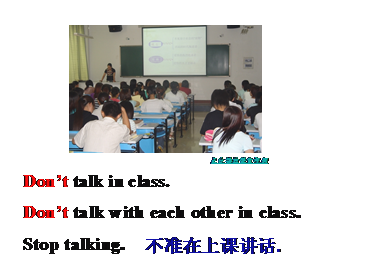

Show the answers and ask Ss to check again and then correct the wrong sentences.
【设计意图】复习上节课所学的内容,进一步巩固所学语言点。确保每一位学生根据图画都能正确表达,让学生刚开始就能体会的学会的愉悦。
Step2:leading in
T: Do you know the school rules at our school?
Ss;Yes, we do.
T: what are the rules?
Group 1: Don’t arrive late for class.
G2: Don’t listen to music in the classroom.
G3: Don’t run in the hallways.
G4: Don’t eat in the classroom
G5: Don’t wear a hat in school.
G6: Don’t talk in class.
Encourage some students use the Chinese if they can’t answer them in English .
【设计意图】小组活动能让学习好的学生带动学困生参与课堂,让学生“兵教兵”,“兵练兵”实现小组互动,活跃课堂气氛。
Step3:Presentation
Task 1: Tell Ss they are going to learn Unit 4 Grammar Focus -3c. And let Ss try to find The Imperative Sentences and translate all the sentences into Chinese. At last lead Ss to watch the following sentences:
肯定祈使句 否定祈使句
Come in , please . Don’t come in .
Be quick, please. Don’t be quick.
Let him come here. Don’t Let him come here.
Have Ss read them aloud for one minute, and after that, ask Ss to talk about these sentences in groups and try to find the things in common. Then let the Ss show their own ideas, and show the completed summary on the screen and the Ss can take the opportunity to check their own ideas.
l 祈使句: 是用来表示请求、命令、叮嘱、号召或者劝告等的句子.
l 祈使句有肯定和否定两种.
祈使句肯定句的表现形式:
|
Do 型 |
动词原形(+宾语)+其他 |
Come in , please . |
|
Be型 |
Be +表语+其他 |
Be quick, please. |
|
Let型 |
Let + 宾语+ 动词原形+其他 |
Let him come here. |
祈使句否定句的表现形式:
|
Do 型 |
Don’t+ 动词原形(+宾语)+其他 |
Don’t come in . |
|
Be型 |
Don’t+ Be +表语+其他 |
Don’t be quick. |
|
Let型 |
Don’t+ let + 宾语+ 动词原形+其他 |
Don’t Let him come here. |
小注:表示禁止性的祈使句:No + 名词/ 动词-ing.
No photos.( 禁止拍照 ) No smoking. ( 禁止抽烟 )
l 标志:没有主语。这类句子的主语常是第二人称you,也就是听话者,因而you常省去。祈使句的开头是动词原形。
趣味助记:
祈使句的用法
祈使句, 祈使句, 请求、命令和建议,
主语是you 常省去,动词原形开头记。
否定形式要注意,句首要把Don’t加。
要讲客气please,句首句末没关系。
Task 2:
1.Tell Ss to go on learning the rest sentences of Unit 4 Grammar Focus -3c.
And talk about what they have to /must do at home /school impairs.
2. Ask three pairs to share their results in front of class.
3. Have Ss find “have to/must” ,and talk about the usage of them. Finally show the results that they talked about on PPT.
情态动词have to 的用法:
² 意思是“必须、不得不”。
(1) 结构:主语+have to+动词原形+其他 (一般现在时,主语是第三人称单数时has to;句子是过去时用had to), 如
2) 否定形式:主语+don’t have to+动词原+其他 (一般现在时,主语是第三人称单数用doesn’t have to; 句子是过去时用didn’t have to), 如:
Nick doesn’t have to wear a uniform. 尼克不必穿制服。
We didn’t have to do our homework at once. 我们不必马上完成作业。
3) 疑问句: Do (Does或Did) +主语+have to +动词原形+其他?
如:— Do you have to stay at home on weekends? 周末你必须待在家里吗?
—Yes, I do. / No, I don’t. 是的, 我必须。/不, 我不必
² 标志:它侧重于客观上的必要和外界的权威。
【设计意图】用小组合作探究的方式,引导学生观察、比较、归纳,进而学得新知识。从而培养学生观察、比较、总结的能力。
4)have to 与must的区别:have to 表示客观上的必须;
must 表示主观上的必须。
如:It is late now. I have to go home.现在天晚了。我必须回家了。(天晚是客观条件,所以用have to)
I must do my homework every day.我必须每天做我的家庭作业。(我主观要求必须做,所以用must)
Step3:Practice
Ask Ss to look at the signs and write the library rules according to the signs .
One minute after check the answers.
Library Rules
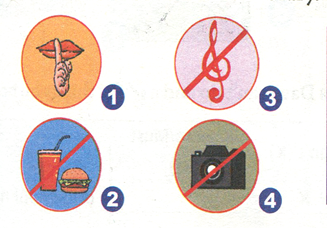
【设计意图】通过写图书馆规则让学生进一步巩固祈使句的用法,使学生学以致用。
Step4:Pair work
Tell Ss We can’t rule the country without rules.( 没有规章制度就不能治理好国家。)And then show the following the rules and say what else do we have to do ?Ask Ss to use the following information to make some conversations in pairs .They can begin like this:
Sample:
A: What do you have to do at school?
B: We have to wear uniforms at school.
1. Wear uniforms at school.
2. Clean the classrooms every day.
3. Don’t play football in the streets .
4. Get up early.
……
They also can use more rules to make up conversations. Give more encouragement to Ss.
【设计意图】积极为学生创设语言环境,让学生在自主学习和交流中感受语法,发展学生的语言表达能力。
Step5: Group work
Ask the Ss to use the words to make questions about the rules .And then talk about the answers in groups and find out the differences and correct the wrong answers.
1. Be quiet?
Q: Does she have to be quiet in the library?
(she/have to/in the library)?
A: Yes ,she does.
2. Eat?
Q:______________________________________________________
(he/have to/in the dining hall)?
A:__________________
3. Listen to music?
Q:______________________________________________________
(we/can/in the hallways)?
A: __________________
4.Wear a hat?
Q:______________________________________________________
(we/can/in the classroom)?
A:__________________
【设计意图】本环节是在语言表达的基础上,练习学生的语言运用能力。
Step6: Writing
Show Ss a sample to get Ss to practice writing . And make our school rules:
Dear students:
In order that we can have a good environment (环境). We should have some rules in our school. Here are some suggestions, we hope that all of us can have a look at them.
1. Don’t sleep in class.
2. Clean the classroom every day.
3. __________________________
4. __________________________
5. __________________________
6. __________________________
Yours
3c After that get Ss to make up five cool rules for your dream school. Share their rules with the class. They can do like this:
1.We don’t have to come to school every day
2.We can eat in class.
3. We don’t have to wear uniforms in school.
…
【设计意图】让学生在实际运用在学会运用祈使句以及have to 的用法。
Step7: Summary
1. Lead the Ss to have a summary about The Imperative Sentence It includes Fuction—when to use the grammar.
2. Show the teacher’s summary on the screen in order to help the Ss to check their own summary.
祈使句: 是用来表示请求、命令、叮嘱、号召或者劝告等的句子.
祈使句有肯定和否定两种句式结构。
句子的主语常是第二人称you,也就是听话者, you常省去。祈使句的开头是动词原形。
情态动词have to 的用法:意思是“必须、不得不”
句式转换应加助动词。
【设计意图】学生在教师的指导下进行语法总结,同时增强了学生的自主学习的能力。逐步形成有效的学习策略。
Step7: The end-of-class test
Ⅰ. 把下列祈使句改成否定句
1. Sit down.
2. Come in.
3. Eat at home.
Ⅱ. Form sentences. 组句
1. sports shoes, you, wear, for, gym class, have to
2. music, listen to, in the classroom, don't
3. eat, can't, in the classroom, we
Ⅲ.用have to或has to填空
1. We _______ clean our classroom after school.
2. She _______ make her bed after getting up.
3. It’s late. Mr. Beckman _______ go to work by car.
4. Emily and Peter join a music club. They ________ practice guitar every day.
Step8: Homework
Write five cool rules for our dream school.
n The answers :
Step3:Practice
1.Don’t talk
2.Don’t eat.
3Don’t listen to music
4.Don’t take photos.
Step5: Group work
2.Does he have to eat in the dining hall?
Yes, he does
3.Can we listen to music in the hallways?
No, we can’t.
4.Can we wear a hat in the classroom?
No, we can’t.
Step6: Writing
3.Don’t fight with each other.
4.Say“hello”to the teachers every day.
5.Don’t bring food to school.
6.Listen to the teacher carefully.
Step7: The end-of-class test
Ⅰ. 把下列祈使句改成否定句
1.Don’t sit down.
2.Don’t come in.
3.Don’t eat at home.
Ⅱ. Form sentences. 组句
1.You have to wear sports shoes for gym class.
2.Don’t listen to music in the classroom
3.We can’t eat in the classroom
Ⅲ. 用have to或has to填空
1.have to 2.has to 3.has to 4.have to
教学反思
祈使句对于七年级的学生来说学起来并不简单。语法教学相对于其他知识的学习,往往让学生感觉枯燥难懂,所以在知识的学习中要设计合理的教学环节和教学活动。
首先 ,让学生从已学的知识入手,让学生感觉的知识并不难。为了避免枯燥,为学生努力营造轻松活泼的学习氛围。并加强了情景教学。
其次,在教学过程中,运用了现代化的教学手段,尽可能的调动学生的多种感官协同作用,使英语学习多样化。
并且最后通过让学生自己观察句子结构、然后归纳、总结,让学生参与到课堂当中,成为课堂的主体。让学生从而体会到“我学习,我快乐!”“我努力。我收获!”

通讯地址: 广州市天河区东圃黄村龙怡苑 (510660)邮箱:lzm6308@163.com 联系QQ:534386438
Copyright © 2008-2012 klxkc.com All Rights Reserved. 粤ICP备15026984号-1
